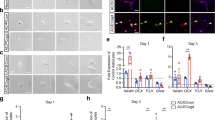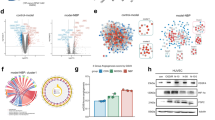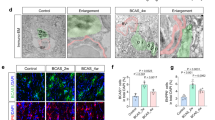Abstract
Angiogenesis and neurogenesis are crucial processes for brain tissue repair and remodeling after brain injury. Current study shows that microRNA-210 (miR-210) promotes vascular endothelial cell migration and tube formation under hypoxia in vitro. Whether miR-210 overexpression promotes focal angiogenesis and neurogenesis in the normal adult brain is unknown. Adult male C57BL/6 mice (n=54) underwent stereotactic injection of a lentiviral vector carrying miR-210 (LV-miR-210). Following 28 days of miR-210 gene transfer, endothelial cell and neural precursor cell proliferation, microvessel density and downstream angiogenic factor were genotyped. miR-210 was highly expressed in neurons, astrocytes and endothelial cells of the LV-miR-210-injected brain hemisphere. The endothelial cell proliferation and the number of newly formed microvessels were greatly increased in the LV-miR-210-treated mice compared with the controls (P<0.05). Neural progenitor cells in the subventricular zone were greatly increased compared with the controls (P<0.05). The data indicate that miR-210 is a key factor at the microRNA level in promoting angiogenesis and neurogenesis, which was associated with local increased vascular endothelial growth factor (VEGF) levels, suggesting that miR-210 may be a potential target for ischemic stroke therapy.
This is a preview of subscription content, access via your institution
Access options
Subscribe to this journal
Receive 12 print issues and online access
$259.00 per year
only $21.58 per issue
Buy this article
- Purchase on Springer Link
- Instant access to full article PDF
Prices may be subject to local taxes which are calculated during checkout







Similar content being viewed by others
References
Sun Y, Jin K, Xie L, Childs J, Mao XO, Logvinova A et al. VEGF-induced neuroprotection, neurogenesis, and angiogenesis after focal cerebral ischemia. J Clin Invest 2003; 111: 1843–1851.
Yang JP, Liu HJ, Liu XF . VEGF promotes angiogenesis and functional recovery in stroke rats. J Invest Surg 2010; 23: 149–155.
Liu Y, Sun L, Huan Y, Zhao H, Deng J . Application of bFGF and BDNF to improve angiogenesis and cardiac function. J Surg Res 2006; 136: 85–91.
Zhang L, Hu Y, Sun CY, Li J, Guo T, Huang J et al. Lentiviral shRNA silencing of BDNF inhibits in vivo multiple myeloma growth and angiogenesis via down-regulated stroma-derived VEGF expression in the bone marrow milieu. Cancer Sci 2010; 101: 1117–1124.
Zhu W, Fan Y, Hao Q, Shen F, Hashimoto T, Yang GY et al. Postischemic IGF-1 gene transfer promotes neurovascular regeneration after experimental stroke. J Cereb Blood Flow Metab 2009; 29: 1528–1537.
Dempsey RJ, Sailor KA, Bowen KK, Tureyen K, Vemuganti R . Stroke-induced progenitor cell proliferation in adult spontaneously hypertensive rat brain: effect of exogenous IGF-1 and GDNF. J Neurochem 2003; 87: 586–597.
Lu H, Wang Y, He X, Yuan F, Lin X, Xie B et al. Netrin-1 hyperexpression in mouse brain promotes angiogenesis and long-term neurological recovery after transient focal ischemia. Stroke 2012; 43: 838–843.
Fan Y, Shen F, Chen Y, Hao Q, Liu W, Su H et al. Overexpression of netrin-1 induces neovascularization in the adult mouse brain. J Cereb Blood Flow Metab 2008; 28: 1543–1551.
Valable S, Montaner J, Bellail A, Berezowski V, Brillault J, Cecchelli R et al. VEGF-induced BBB permeability is associated with an MMP-9 activity increase in cerebral ischemia: both effects decreased by Ang-1. J Cereb Blood Flow Metab 2005; 25: 1491–1504.
Fiore R, Khudayberdiev S, Saba R, Schratt G . MicroRNA function in the nervous system. Prog Mol Biol Transl Sci 2011; 102: 47–100.
Van Wynsberghe PM, Chan SP, Slack FJ, Pasquinelli AE . Analysis of microRNA expression and function. Methods Cell Biol 2011; 106: 219–252.
Jain KK . Nanobiotechnology-based drug delivery to the central nervous system. Neurodegener Dis 2007; 4: 287–291.
Du T, Zamore PD . microPrimer: the biogenesis and function of microRNA. Development 2005; 132: 4645–4652.
Pillai RS . MicroRNA function: multiple mechanisms for a tiny RNA? RNA 2005; 11: 1753–1761.
Liu DZ, Tian Y, Ander BP, Xu H, Stamova BS, Zhan X et al. Brain and blood microRNA expression profiling of ischemic stroke, intracerebral hemorrhage, and kainate seizures. J Cereb Blood Flow Metab 2010; 30: 92–101.
Chan SY, Loscalzo J . MicroRNA-210: A unique and pleiotropic hypoxamir. Cell Cycle 2010; 9: 6.
Fasanaro P, Greco S, Lorenzi M, Pescatori M, Brioschi M, Kulshreshtha R et al. An integrated approach for experimental target identification of hypoxia-induced miR-210. J Biol Chem 2009; 284: 35134–35143.
Fasanaro P, D'Alessandra Y, Di Stefano V, Melchionna R, Romani S, Pompilio G et al. MicroRNA-210 modulates endothelial cell response to hypoxia and inhibits the receptor tyrosine kinase ligand Ephrin-A3. J Biol Chem 2008; 283: 15878–15883.
Pulkkinen K, Malm T, Turunen M, Koistinaho J, Yla-Herttuala S . Hypoxia induces microRNA miR-210 in vitro and in vivo ephrin-A3 and neuronal pentraxin 1 are potentially regulated by miR-210. FEBS Lett 2008; 582: 2397–2401.
Liu F, Lou YL, Wu J, Ruan QF, Xie A, Guo F et al. Upregulation of microRNA-210 regulates renal angiogenesis mediated by activation of VEGF signaling pathway under ischemia/perfusion injury in vivo and in vitro. Kidney Blood Press Res 2011; 35: 182–191.
Hu S, Huang M, Li Z, Jia F, Ghosh Z, Lijkwan MA et al. MicroRNA-210 as a novel therapy for treatment of ischemic heart disease. Circulation 2010; 122 (11 Suppl): S124–S131.
Raitoharju E, Lyytikainen LP, Levula M, Oksala N, Mennander A, Tarkka M et al. miR-21, miR-210, miR-34a, and miR-146a/b are up-regulated in human atherosclerotic plaques in the Tampere Vascular Study. Atherosclerosis 2011; 219: 211–217.
Zeng L, Liu J, Wang Y, Wang L, Weng S, Tang Y et al. MicroRNA-210 as a novel blood biomarker in acute cerebral ischemia. Front Biosci (Elite Ed) 2011; 3: 1265–1272.
Matrai J, Chuah MK, VandenDriessche T . Recent advances in lentiviral vector development and applications. Mol Ther 2010; 18: 477–490.
Bokhoven M, Stephen SL, Knight S, Gevers EF, Robinson IC, Takeuchi Y et al. Insertional gene activation by lentiviral and gammaretroviral vectors. J Virol 2009; 83: 283–294.
Manilla P, Rebello T, Afable C, Lu X, Slepushkin V, Humeau LM et al. Regulatory considerations for novel gene therapy products: a review of the process leading to the first clinical lentiviral vector. Hum Gene Ther 2005; 16: 17–25.
Zhao H, Pestina TI, Nasimuzzaman M, Mehta P, Hargrove PW, Persons DA . Amelioration of murine beta-thalassemia through drug selection of hematopoietic stem cells transduced with a lentiviral vector encoding both gamma-globin and the MGMT drug-resistance gene. Blood 2009; 113: 5747–5756.
Font MA, Arboix A, Angiogenesis Krupinski J . neurogenesis and neuroplasticity in ischemic stroke. Curr Cardiol Rev 2010; 6: 238–244.
Liu XS, Zhang ZG, Zhang RL, Gregg S, Morris DC, Wang Y et al. Stroke induces gene profile changes associated with neurogenesis and angiogenesis in adult subventricular zone progenitor cells. J Cereb Blood Flow Metab 2007; 27: 564–574.
Hayashi T, Deguchi K, Nagotani S, Zhang H, Sehara Y, Tsuchiya A et al. Cerebral ischemia and angiogenesis. Curr Neurovasc Res 2006; 3: 119–129.
Slevin M, Kumar P, Gaffney J, Kumar S, Krupinski J . Can angiogenesis be exploited to improve stroke outcome? Mechanisms and therapeutic potential. Clin Sci (Lond) 2006; 111: 171–183.
Madri JA . Modeling the neurovascular niche: implications for recovery from CNS injury. J Physiol Pharmacol 2009; 60 (Suppl 4): 95–104.
Ohab JJ, Fleming S, Blesch A, Carmichael ST . A neurovascular niche for neurogenesis after stroke. J Neurosci 2006; 26: 13007–13016.
Shen F, Fan Y, Su H, Zhu Y, Chen Y, Liu W et al. Adeno-associated viral vector-mediated hypoxia-regulated VEGF gene transfer promotes angiogenesis following focal cerebral ischemia in mice. Gene Therapy 2008; 15: 30–39.
Wang YQ, Cui HR, Yang SZ, Sun HP, Qiu MH, Feng XY et al. VEGF enhance cortical newborn neurons and their neurite development in adult rat brain after cerebral ischemia. Neurochem Int 2009; 55: 629–636.
Wiltrout C, Lang B, Yan Y, Dempsey RJ, Vemuganti R . Repairing brain after stroke: a review on post-ischemic neurogenesis. Neurochem Int 2007; 50: 1028–1041.
Shimpo M, Ikeda U, Maeda Y, Takahashi M, Miyashita H, Mizukami H et al. AAV-mediated VEGF gene transfer into skeletal muscle stimulates angiogenesis and improves blood flow in a rat hindlimb ischemia model. Cardiovasc Res 2002; 53: 993–1001.
Hua Z, Lv Q, Ye W, Wong CK, Cai G, Gu D et al. MiRNA-directed regulation of VEGF and other angiogenic factors under hypoxia. PLoS One 2006; 1: e116.
Yang W, Sun T, Cao J, Liu F, Tian Y, Zhu W . Downregulation of miR-210 expression inhibits proliferation, induces apoptosis and enhances radiosensitivity in hypoxic human hepatoma cells in vitro. Exp Cell Res 2012; 318: 944–954.
Chan SY, Zhang YY, Hemann C, Mahoney CE, Zweier JL, Loscalzo J . MicroRNA-210 controls mitochondrial metabolism during hypoxia by repressing the iron-sulfur cluster assembly proteins ISCU1/2. Cell Metab 2009; 10: 273–284.
Chen Z, Li Y, Zhang H, Huang P, Luthra R . Hypoxia-regulated microRNA-210 modulates mitochondrial function and decreases ISCU and COX10 expression. Oncogene 2010; 29: 4362–4368.
Kim HW, Haider HK, Jiang S, Ashraf M . Ischemic preconditioning augments survival of stem cells via miR-210 expression by targeting caspase-8-associated protein 2. J Biol Chem 2009; 284: 33161–33168.
Mutharasan RK, Nagpal V, Ichikawa Y, Ardehali H . microRNA-210 is upregulated in hypoxic cardiomyocytes through Akt- and p53-dependent pathways and exerts cytoprotective effects. Am J Physiol Heart Circ Physiol 2011; 301: H1519–H1530.
Mikalsen LT, Dhakal HP, Bruland OS, Nesland JM, Olsen DR . Quantification of angiogenesis in breast cancer by automated vessel identification in CD34 immunohistochemical sections. Anticancer Res 2011; 31: 4053–4060.
Acknowledgements
This study is supported by 973 Program of NBRP, China (2011CB504405, GYY, YW), NSFC (30973097, GYY, 81200943, LZ), the Shanghai medical association (SHNR-003, LZ), Shanghai healthy bureau (20124217, LZ) and by the Science and Technology Commission of Shanghai Municipality (12ZR1418600, FY).
Author information
Authors and Affiliations
Corresponding authors
Ethics declarations
Competing interests
The authors declare no conflict of interest.
Rights and permissions
About this article
Cite this article
Zeng, L., He, X., Wang, Y. et al. MicroRNA-210 overexpression induces angiogenesis and neurogenesis in the normal adult mouse brain. Gene Ther 21, 37–43 (2014). https://doi.org/10.1038/gt.2013.55
Received:
Revised:
Accepted:
Published:
Issue Date:
DOI: https://doi.org/10.1038/gt.2013.55
Keywords
This article is cited by
-
Emerging Targets for Modulation of Immune Response and Inflammation in Stroke
Neurochemical Research (2023)
-
HIF1A promotes miR-210/miR-424 transcription to modulate the angiogenesis in HUVECs and HDMECs via sFLT1 under hypoxic stress
Molecular and Cellular Biochemistry (2022)
-
MicroRNA-210 Regulates Dendritic Morphology and Behavioural Flexibility in Mice
Molecular Neurobiology (2021)
-
Electroacupuncture reduces scopolamine-induced amnesia via mediating the miR-210/SIN3A and miR-183/SIN3A signaling pathway
Molecular Medicine (2020)
-
MiRNA-210 induces microglial activation and regulates microglia-mediated neuroinflammation in neonatal hypoxic-ischemic encephalopathy
Cellular & Molecular Immunology (2020)



